Passive natural immunity transfer in pigs from two different commercial breeding farms was determined. For this purpose, blood from 221 pigs, 24 hours after being born and 21 mothers pigs, were taken. The pigs from each farm were separated into two groups consisting of approximately 50 individuals each. The first group was treated as usually done by the farm owners, and to the second, an immunomodulator product (produced with LPS), was to the mothers given. Obtained serums were by means of cellulose acetate electrophoresis, immunoelectrophoresis, quantitative radial immunodiffusion and zinc sulfate turbidity tests analyzed. Total protein concentration was determined using a Golberg refractometer. Obtained results were analyzed and the importance of an adequate natural passive immunity transfer is discussed. Also discussed is the possible use of the immunodulator in commercial pig breeding farms that present high rates of neonatal morbimortality.
keywords:
Passive immunity in pigs, passives antibodies, immunoglobulins concentrations, colostrum, immunomodulators.





